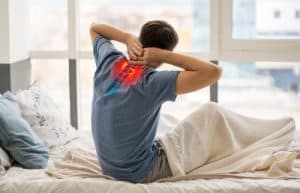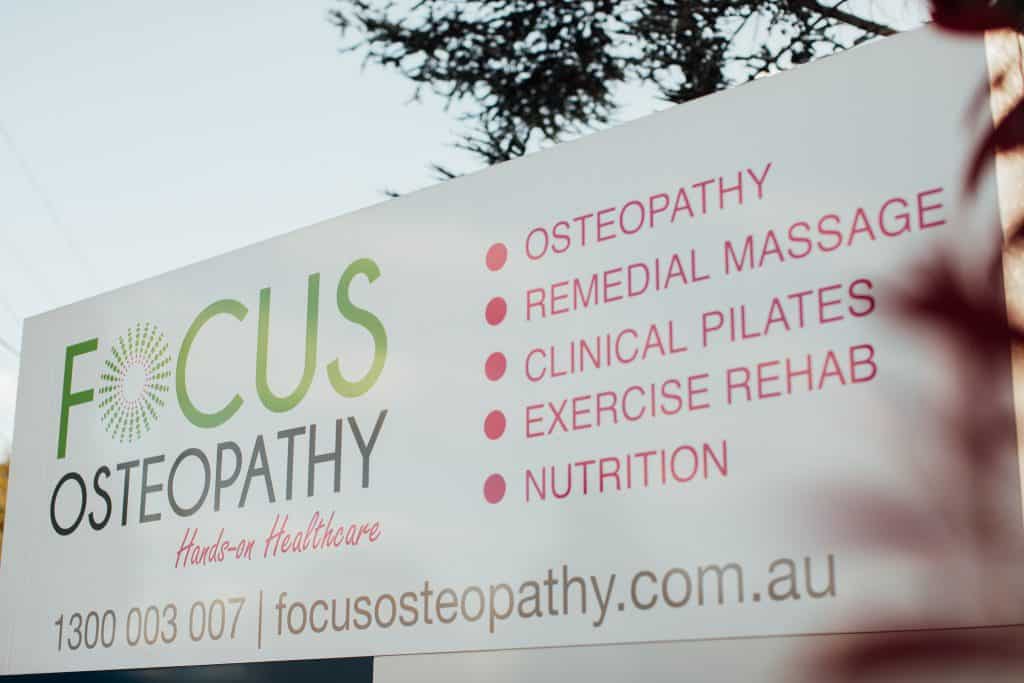
As a definition, Patellofemoral Dysfunction is the pain that you feel in the front of your knee when your patella, (knee cap), doesn’t glide properly across the end of your femur (thigh bone).
The condition is most often found in teenagers, and the majority of cases – according to medical researchers – tend to be female. Although, that doesn’t mean you are ‘risk-free’ just because you are older, or male!
Common causes include Weakness/Imbalances or tightness of the muscles and tendons associated with the patella and/or hip joint, poor biomechanics of the lower limb, overuse (particularly with activity/sports involving running or jumping) & previous injury or surgery to the femur or patella.
More Blogs From Focus Osteopathy

Knee Pain: The Good, The Bad, and the OUCH!

4 Reasons Swimming Is Good For Back Pain

8 Ways Neck Pain Can Disrupt Your Daily Life—and How Osteopathy Can Help

Understanding Back Pain: The Unwanted Companion

Does Massage Therapy Help Sciatica? 4 Things You Must Know

Neck Pain Exercises to Help You Sleep
When the condition arises in children, weak hips, weakened core muscles, flat feet, and damaged muscles in the upper thigh are usually the root causes.
But what does that mean for people who suffer from patellofemoral dysfunction?
If the condition goes untreated, then the knee pain will only get worse and begin to affect your quality of life. Patellofemoral dysfunction can also cause a domino effect that creates discomfort in other parts of the body.
What Causes Patellofemoral Dysfunction?

While doctors cannot pinpoint the exact cause or generalize the condition’s origins, patellofemoral dysfunction has been associated with muscle imbalances and weaknesses, alongside overuse of the kneecap, injury, and surgery.
Sports that involve running, jumping, and repetitive stress can irritate the kneecap, which in turn affects the kneecap’s ability to function smoothly. Patellofemoral pain can also radiate downwards because of weakness in the muscles of the hip area, preventing the kneecap from being properly aligned.
When the kneecap is misaligned, inward movement of the knee during activity (such as a squat) have also been associated with patellofemoral dysfunction. The condition also commonly arises following injury to the knee, such as a dislocation or fracture.
Surgery can increase the risk of patellofemoral discomfort, especially where surgeons repair the anterior cruciate ligament using the patellar tendon as a graft.
Who Is At Risk?

It’s typical for patellofemoral pain to affect adolescents and young adults. Although anyone can develop the condition, knee pain in older individuals tends to revolve more commonly around arthritis.
According to medical researchers, women are twice as likely to develop the condition when compared to men. It has been suggested that women are more at risk because of their wider pelvis, which increases the angle where the bones in the knee joint meet.
If you have a relatively inactive lifestyle, the risk of patellofemoral dysfunction can be higher. By remaining sedentary, muscle mass cannot be built nor maintained, and without the strength of certain muscles that retain balance and keep joints aligned, patellofemoral issues can occur.
Participation in athletic activities, or ‘hard-wearing’ sports, can put extra stress on your knees – especially when training and trying to up your level of fitness.
Your weight also plays a part. Individuals who are overweight exhibit increasing mechanical overuse of their patellofemoral joints. This speeds up the rate of cartilage degeneration and increases the risk of problems with tendons and stability issues.
Can You Prevent Patellofemoral Dysfunction?

The answer isn’t quite that simple. Oftentimes, knee pain just happens. It could be something in your genetics, or it could be trauma from an injury that never healed properly.
However, there are steps that you can take to lessen your risk, and that starts by maintaining your strength – which is where we come in.
Strong quadriceps and hip muscles are very important for keeping your knee balanced during daily activity. Flexibility is also imperative for avoiding pain and discomfort, and a physical therapist will be able to help build strength by manipulating and reinforcing your muscles, and guiding the patella track along its groove.
Exercise for your outer hip muscles is especially important in preventing your knee from caving inwards. You may think that an ‘inward’ movement with the knee only happens when being particularly active, but you’d be misinformed. Just walking up and down stairs requires such a movement from your knee and is therefore an action to be mindful of.
We’d recommend that you lose any excess weight that you are carrying on your frame. Losing this weight relieves the stresses on your knees and therefore lessens the chance of patellofemoral dysfunction.
Ensure that your shoes fit comfortably. That probably sounds like really simple advice, but it can make all the difference. If your feet aren’t well supported, then you put an extra burden on other parts of your body – including your lower back, and your knees.
Should your shoes not provide a healthy amount of shock absorption, then your knees take the strain. It’s only a matter of time before the extra stress causes rapid deterioration. Struggling with your shoes? We’d suggest trying insoles or a heel lift out for size.
If you are in training for any form of sporting event, make sure that you warm up before tackling any forms of exercise. By promoting flexibility in your body before tackling physical activity, you avoid sudden changes in how intensely your body has to function. Increase your intensity gradually, rather than going ‘all in’ without preparation.
How Important Is Your Knee?

The quick answer? Your knee is very important, and your mobility (and independence) practically depends on it.
Your knee is a complex structure and one of the most stressed joints in your body. In fact, it’s the largest joint you have, and although it remains vital for movement, it’s also vulnerable to injury.
Comprising of the femur (thigh bone), tibia (shin bone), fibula, and patella (kneecap), the knee is what’s known as a synovial joint; containing a fluid-filled capsule.
There are approximately 14 of these small fluid-filled capsules within the knee joint, and each one is paramount in reducing friction between the tissues of the knee. If these capsules (also known as sacs) become damaged or start to fail, the area begins to suffer inflammation – which can cause serious pain.
Besides supporting the body to maintain an upright position, your knee helps to lower and raise your body while providing stability. We’ve used the term ‘shock absorber’ already in this blog, but it does sum up the activity of your knee.
Your knee also accommodates the twist of your leg, which makes walking easier and more efficient, helping to propel the body forward.
Without the ability to twist or bend your knee, daily tasks and recreational activities can feel almost impossible. Getting to and from work during the commute, partaking in events with your family, or even just running chores, can become difficult and awkward.
So where does the patella fit in?
The patella is a small triangular-shaped bone that rests at the front of the knee, within the quadriceps muscle. Although the patella is lined with the thickest layer of cartilage, it endures such a deal of force that the surrounding muscles need to be in good health to prevent injury or damage.
How Focus Osteopathy Can Help

Seeking help rarely crosses the forefront of the mind until health problems loom large. Urban legend may conjure up images of aggressive massage and hurt, but the truth is very different to that false stereotype.
The movement therapy that we offer is a non-invasive form of treatment, and while you may feel some tenderness in areas that need attention (in this case, your knee), this sensation quickly passes.
We utilize a range of treatment methods that aims to address the root cause of your patellofemoral dysfunction. But we take the time to get to know you first.
Why?
Well, what works for some may not work for others. Everyone is different, and our therapists need to understand your individual situation to craft a bespoke package of care. We never generalize our treatment for patellofemoral dysfunction, as that won’t ensure the best relief from pain for you!
We’ve spent more than two decades working with people of all ages to find relief from acute and chronic knee pain. We remain aware of what people can be told after approaching their doctor, but let me tell you – pills and rest will not solve your situation.
In some cases, pills and painkillers only mask the pain. A prescription for pills is only a short-term solution, and your body eventually becomes less responsive to them.
We would recommend that you reach out to us through our contact page either by filling out a form or contacting us directly by phone to arrange a Free Discovery Visit. If you are ready to find effective pain relief, you can inquire about our cost and availability.
There is no need to suffer in silence. Suffering from general knee pain, or patellofemoral dysfunction, is not something you should have to endure. We’re here to help. So let’s get that ball rolling (or, in this case, cap gliding)!

